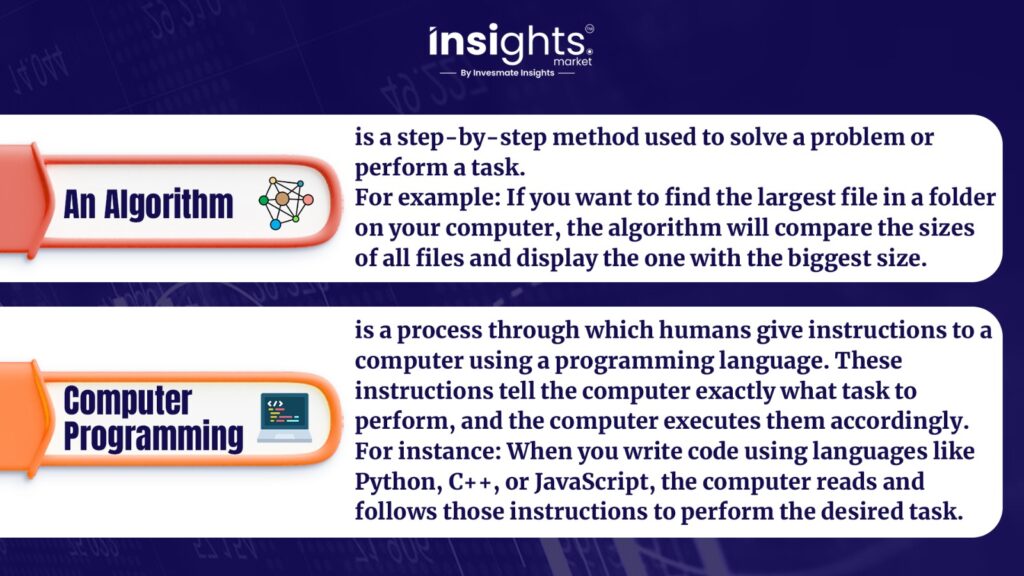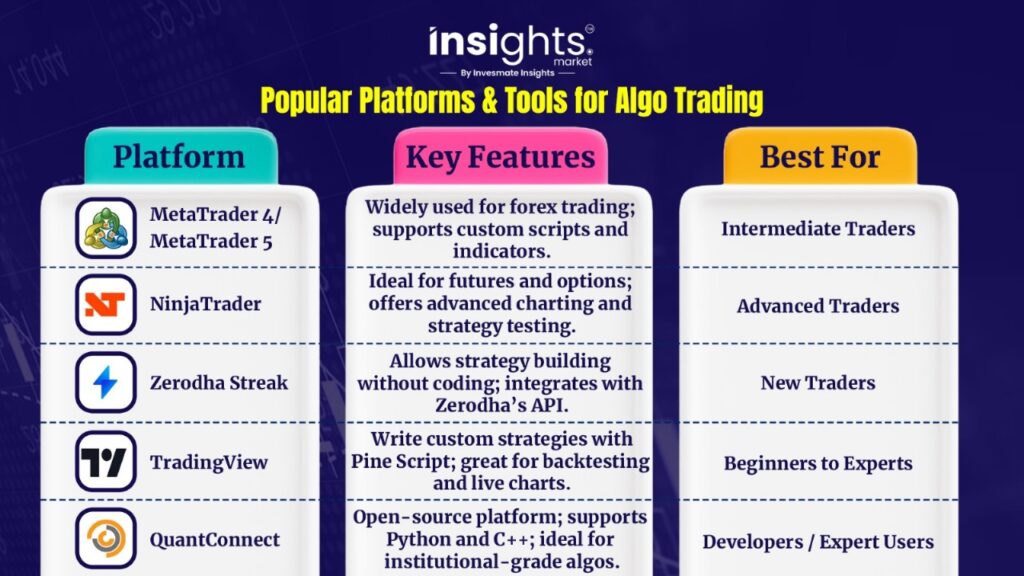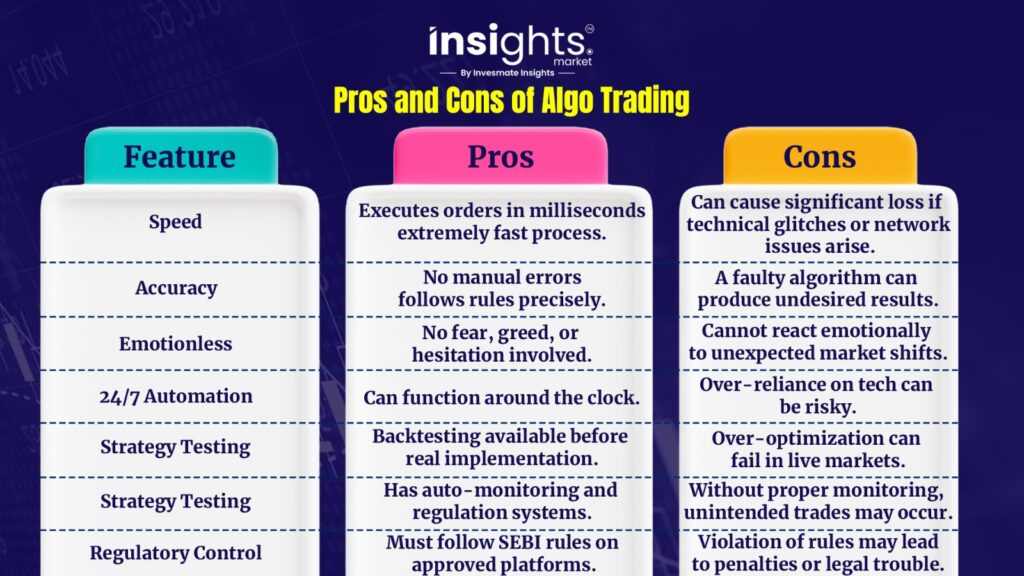![]()
In stock trading, timing is a critical factor. So imagine a trading process that is fast, accurate, and fully automated—would you be interested?
Just think: what if a computer trades in the stock market on your behalf, automatically? It may sound a bit unbelievable, but this is now a reality. In today’s tech-driven trading world, this “impossible” has been made possible through a modern innovation known as Algorithmic Trading, or Algo Trading.
Let’s explore this cutting-edge trading method in detail.

How Technology is Transforming Trading?
In today’s fast-paced financial world, technology has completely changed the way we invest and trade. One of the most impactful innovations in this transformation is Algorithmic Trading or Algo Trading. It is a method where computer programming is used to execute trades automatically based on predefined rules.
In India, Algo Trading is becoming more popular. Many brokers now offer API (Application Programming Interface)-based services, allowing users to create their own trading bots. Once limited to large institutions, this technology is now accessible to individual investors as well.
But first, let’s clarify what Algorithms and Computer Programming are.

What is Algo Trading?
Algo Trading or Algorithmic Trading is a method of trading where computer programs are used to place orders and manage trades in the stock market based on pre-set rules or conditions—like price, trade volume, time, or other statistical indicators.
The primary objective of Algo Trading is to eliminate human emotion and errors, enabling systematic and accurate trading. This allows the simultaneous application of multiple strategies across different markets—quickly and efficiently.
Read Also: Understanding Value Investing: A Simple Guide for Beginners
How Does Algo Trading Work?
A full-fledged Algo Trading system generally functions through the following components:
- Market Data Feed:
Supplies real-time data such as price, volume, and other relevant information, which the algorithm uses for analysis. - Trading Algorithm:
Executes trading strategies based on pre-set rules—for example, when to buy or sell a stock. - Backtesting Module:
Tests the algorithm’s effectiveness using historical market data. - Order Execution System:
Sends pre-defined trade orders to brokers or stock exchanges and ensures their execution. - Risk Management System:
Controls risks using mechanisms like stop-loss, position sizing, etc. - Performance Monitoring:
Regularly reviews and analyzes how effectively the algorithm is working.
Popular Platforms & Tools for Algo Trading

Popular Strategies in Algo Trading
- Trend Following:
Instead of predicting the market, this strategy uses technical indicators like Moving Averages or Moving Average Convergence Divergence (MACD) to follow ongoing trends. - Mean Reversion:
Assumes that if a stock’s price deviates significantly from its average price, it will eventually revert to the mean—buy low, sell high. - Arbitrage:
Exploits price differences of the same asset across different markets—buy low in one, sell high in another. - Market Making:
Places simultaneous buy and sell orders and earns profit from the spread between them, improving market liquidity. - High-Frequency Trading (HFT):
Executes thousands of trades per second to capture small price differences; highly reliant on technology.
Read Also: What is the Difference Between FPI and FDI?
Regulatory Landscape in India
SEBI (Securities and Exchange Board of India) has implemented several important rules to ensure that Algo Trading is safe and fairly conducted in the share market.The rules are:
- Broker Approval: Any algo-based service must first be approved by the concerned stock exchange and the broker.
- Unique Algo ID: Every algo order must carry a unique ID for traceability.
- Retail Trader Registration: Retail traders who execute orders at higher frequencies must register separately for monitoring purposes.
- API Security: Two-factor authentication is mandatory to ensure user identity and secure API-based trading.
- “Kill Switch” Feature: A mandatory feature that immediately halts the algo in case of bugs, errors, or dangerous market moves—protecting against large losses.
These rules provide safety for traders and maintain transparency in the market.
Pros and Cons of Algo Trading

Step-by-Step Guide for Beginners
- Learn the Basics:
Understand trading concepts and strategies. Also, get a basic grasp of Python or any relevant programming language. - Choose the Right Platform:
Start with beginner-friendly tools like Zerodha Streak or TradingView. - Create a Strategy:
Use indicators like Moving Averages or (Relative Strength Index) RSI to develop your own trading strategy. - Backtest:
Test your strategy on historical data to see how it would have performed. - Start Live Trading:
Begin with a small capital and scale up as you gain confidence. - Analyze Performance:
Review your strategy’s performance regularly and refine it when necessary.
Conclusion
Algo Trading is no longer exclusive to large institutions. With the rise of internet access and technology in India, even individual traders now have access to this smart and powerful tool.
For those who want to trade strategically, emotion-free, and in less time, Algo Trading opens a new horizon of opportunities. However, it’s essential to remember that—without proper knowledge, experience, and adherence to regulations—this technology can also lead to significant losses.
With the right preparation and responsible usage, Algo Trading can become your key to smart and successful investing in the future.
FAQs
No, No trading method is 100% risk-free. Glitches, coding errors, or market volatility can cause losses. Regular monitoring and setting stop-losses are crucial.
Some platforms like Zerodha Streak or TradingView allow strategy building without coding. However, knowledge of Python, C++, or Pine Script can help you build advanced algorithms.
Yes, but it must be approved by both your broker and the stock exchange as per SEBI regulations. Proper backtesting and risk management are also necessary.
You can start with a regular desktop or laptop. For High-Frequency Trading (HFT), a dedicated server and low-latency network are required. For general users, cloud-based or API-integrated platforms are sufficient.
Yes. Platforms like Zerodha Kite, Streak, and TradingView offer mobile apps where you can build, modify, and execute strategies. However, full custom deployment is best done on a desktop.
It depends on the strategy. Well-tested and carefully implemented strategies can generate consistent profits, but no method guarantees returns.




